
15 minute read
Solo & Small FirmCommittee Networking Tips for New Attorneys
Whether we like it or not, networking is essential for attorneys. It’s not just what you know, but who you know, that determines your success. By growing your network, you are more likely to get new clients, learn from experienced attorneys, and expand your access to new opportunities. For many lawyers, this is not a skill that comes naturally.
Some attorneys just do not like networking, but the biggest challenge for most attorneys is finding the time to network given the demanding nature of our daily workload. Although we all have work that has to get done, without clients there wouldn’t be any work to do in the first place. It takes time and energy to network, and even more time to build the relationships that are necessary for your professional growth. But the time and effort necessary for networking is well worth it. To be successful at growing your network, you need a system to help you follow through. Here are some tips to get you started. Get involved in the community. Volunteering is a rewarding way to get involved in your community and expand your network. Joining local organizations and regularly attending events is an easy way to meet people and make connections. Whether it’s the Orange County Bar Association (“OCBA”), business networking groups, non-profit boards, or service organizations like Kiwanis and Rotary,, these types of organizations are a great place to meet like-minded professionals and build your community. When seeking out an organization to join, begin by identifying your networking goals and research organizations that align with those objectives. Consider the organization’s mission, reputation, and networking opportunities. Start by attending as a guest and ask around to get recommendations from people you know that already have some experience with the organization. If possible, choose an organization that is a good fit for your practice area and resonates with your own values. Remember that networking is a personal journey, and exploring different organizations can help you find the best fit for your professional growth and networking success.

Don’t forget to build relationships with professionals outside the legal field as well. Depending on your practice area, consider which professionals are doing business with your potential clients. For example, if you’re an estate planning attorney, you may want to connect with accountants and financial advisors. Find out what organizations they are participating in and join them. Meet other attorneys. Attending legal events and conferences, as well as joining the OCBA, can help you meet other attorneys and build relationships with attorneys who specialize in different practice areas. Attending OCBA events or joining an OCBA committee is the easiest way to meet other attorneys. Think about what practice areas are most complementary to yours that will result in the best referrals. While at these events, ask for business cards and make sure to add them to your database. If you prefer meeting online, you can always join online groups, like a Facebook group for lawyers. To effectively participate in online communities, share valuable content, be an active participant, and consistently engage in conversations. Some attorneys do this using their personal network on their own Facebook page. Although it’s easy to hit the “like” button and keep scrolling, commenting is how you engage in a meaningful conversation.
Develop a top 20 list of referral sources. Identify the top twenty attorneys or contacts who consistently refer business to you. The purpose of creating a top twenty list is to prioritize and focus on nurturing relationships with the people who provide you with the best referrals. By maintaining regular communication and staying top-of-mind with these referral sources, you can strengthen those relationships and encourage continued referrals. When you start your list, you probably will not have twenty good referral sources, but that should be your minimum goal. Start with a list of people you want to meet and keep working toward adding more names to your list once they’ve made a referral.1 Then, make sure to regularly look at your list and continually make adjustments based on where your referrals are coming from. Prioritize the most beneficial relationships, and nurture those with the most potential.
Let’s do lunch. Orlando has some amazing restaurants, so get out of the office and go enjoy them with a colleague. Sharing a meal in a relaxed atmosphere allows you to connect with your colleague on a personal level. It provides an opportunity to get to know each other better, discuss shared interests, and build rapport. This requires getting out of the office and taking time out of your day, but it is still the best way to get to know someone and start the process of building a professional relationship.2 Much of my career I have done “random acts of lunch” by haphazardly scheduling lunch meetings. Instead, set a goal and have a system, such as scheduling a minimum of three meetings per week. At the end of the month, review the meetings you had and measure your results. If you’re not getting the results you want, you may not be meeting with the right people.
If lunch is not your thing, invite someone for coffee or just hop on Zoom for a quick chat. If you like golf or going to the gym, invite a colleague. Whatever it is you enjoy doing, involve someone else. When you do meet, make sure to be authentic and genuine. Instead of focusing on promoting yourself, ask questions and be an active listener. During the conversation, think of the ways you can help the other person or be a resource for them instead of trying to seek personal gain for yourself. As Zig Ziglar said, “You can have everything in life you want if you will just help enough other people get what they want.” By contributing to the well-being and success of others, you can build trust, and create opportunities for personal growth and achievement.3
Use a Customer Relations Management (“CRM”) tool. While case management software may capture basic contact information, a CRM can help you keep track of your interactions continued page 14 classes), and applies to private employers with 15 or more employees, governments, and their agencies. Employees who sue under Title VII raise either disparate treatment or disparate impact claims. A disparate treatment claim alleges an employee was intentionally discriminated against because of their protected class; a disparate impact claim alleges an employee was adversely affected by an otherwise neutral rule, requirement, or process. For example, a disparate impact claim may arise when an otherwise neutral policy restricting certain hairstyles may adversely affect an employees’ culture.
Third, State laws must afford the same or more rights than what the Federal law provides. For example, the FMLA entitles protected employees to twelve weeks of unpaid leave in a twelve-month period to page 13 with the contacts that you make. There are free options available, like HubSpot, or you can use a spreadsheet, but the important thing is to track your activity. Meeting someone is just the first step in building a relationship. It takes repeated interactions to establish the trust necessary for referrals. The ability of a CRM to track and record interactions helps to maintain a history of your relationships, and more easily schedule reminders and follow-up tasks. Whether it’s sending a follow-up email, making a phone call, or scheduling a meeting, a CRM can help you stay organized and consistent in nurturing your relationships. Follow up with clients and referral sources. Sending a follow-up email or handwritten note after meeting with a client or referral source can show your appreciation and keep the relationship alive. Make sure to use your CRM or calendar to schedule time to follow up with your con- handle medical emergencies. The States are not permitted to provide less than twelve weeks of unpaid leave for medical emergencies; however, they can enact laws that provide more employee rights, such as entitling workers to more time off, or requiring that employers pay the workers during their time off. For example, in Washington State, employees are paid while on FMLA leave. tacts. When you see an article or news story that might be relevant to a colleague, send them a quick email with the link. Schedule time on your calendar to make phone calls or send text messages to your contacts just to say hello.
Employment law is ever developing. Just recently, the DOL announced a significant increase in FMLA Audits for employers in certain industries, specifically the warehouse and logistics industries. This means employment practices are being more federally monitored. Also, for the FLSA, the DOL announced a rule proposing further distinctions between an employee and independent contractor.
Ultimately, it is best to defer to your legal counsel in the labor & employment arena. The rules change, and they change rapidly, requiring an innovator and practitioner that can stay ahead of the curve. So, whether you practice labor & employment law or not, you have a leg up if you can get back to basics. As Mr. Gracie noted, the basics build a solid foundation.
Juan P. Camacho, Esq., is Partner at Kaufman Dolowich & Voluck in Orlando, Florida and is also Chair of the Labor & Employment Committee for the Orange County Bar Association. He has been a member of the OCBA since 2021.
Jessica Cousset, Esq., is an Associate Attorney at Kaufman Dolowich & Voluck in Fort Lauderdale, Florida.
Start an email newsletter. Sending out a monthly or quarterly newsletter to keep your contacts informed about your practice can be an effective way to stay in touch and build your reputation. You can share relevant industry news, legal updates, or your practice’s recent achievements. This helps position you as a valuable resource and keeps you top of mind. It doesn’t have to be a lengthy email with lots of original content. It could be as simple as sharing links to three of your favorite articles of the month. At my firm, we have different newsletters for different mailing lists. For clients, we have a monthly newsletter that includes firm news, safety tips, and a community calendar for upcoming events. For colleagues, we have a newsletter called, “Todd’s Three Things,” that includes three random things I am interested in that month, and a “Marketing Minute” email that includes a monthly marketing tip.4 These are just a few suggestions to get you started on your professional network. Remember, building a network takes time and effort. At the core of any good relationship is trust and likability, so approach networking with authenticity, a willingness to help others, and a genuine interest in building mutually beneficial relationships. As a result, you’ll have more meaningful professional relationships and a more meaningful career.
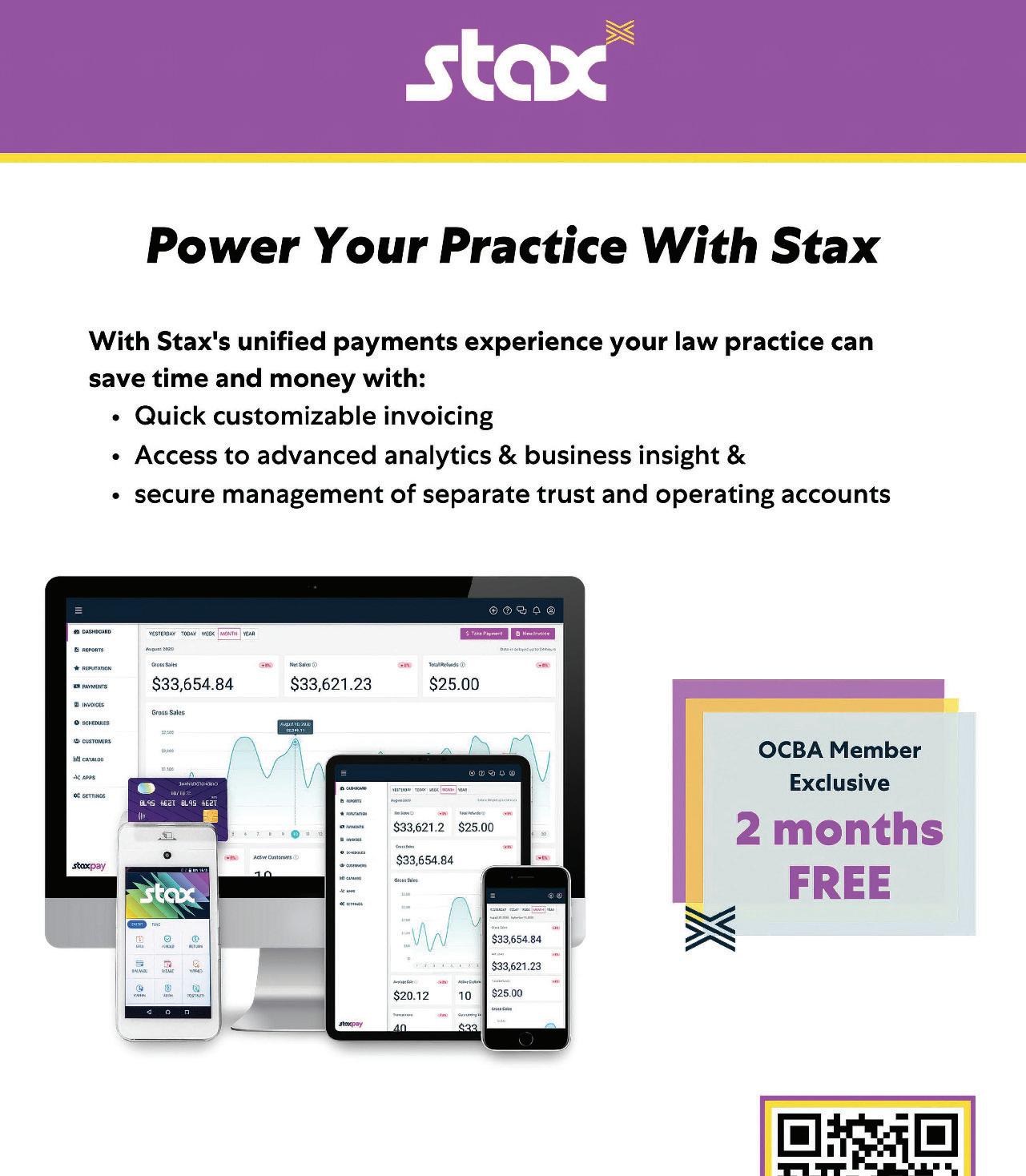
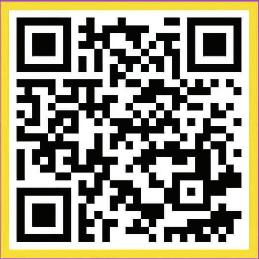

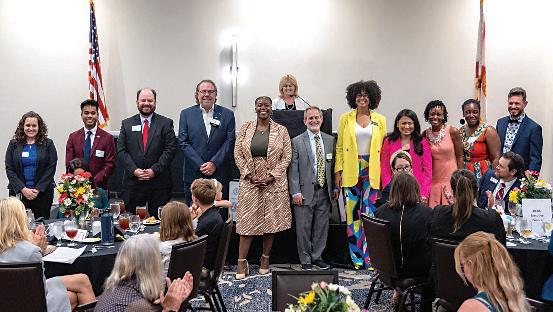
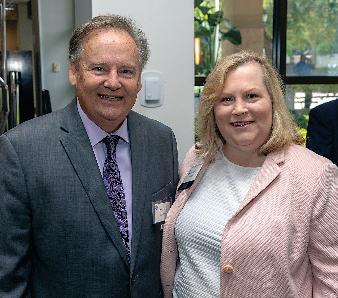
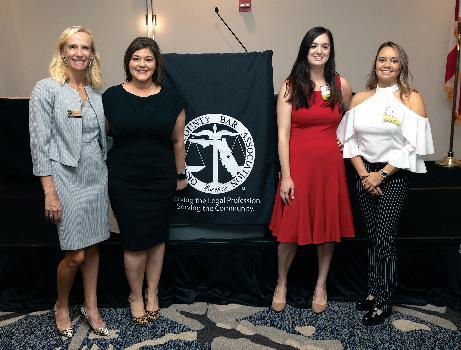
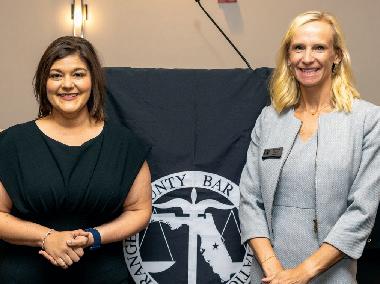
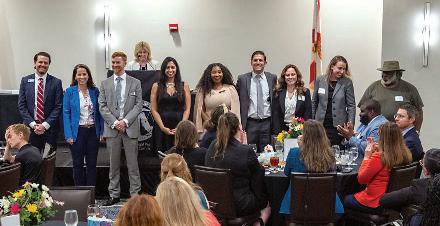
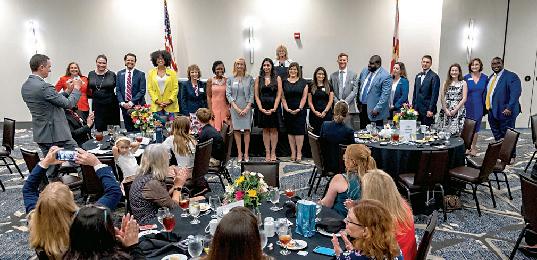
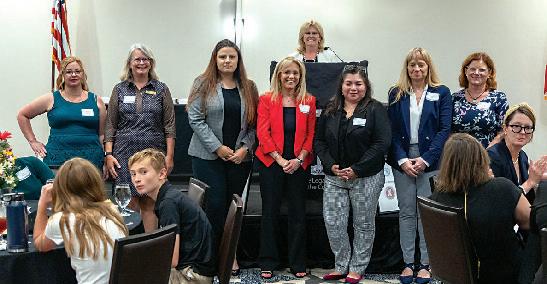
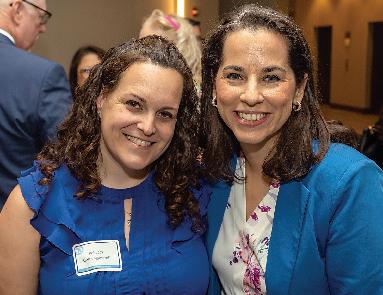
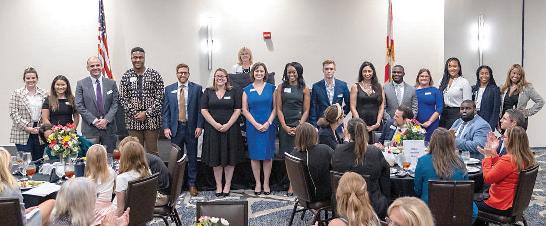
OCBA Installation Luncheon
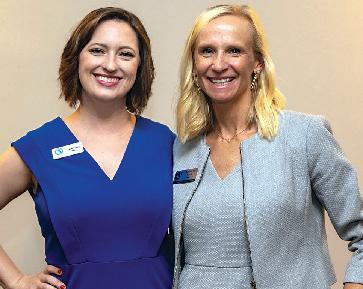
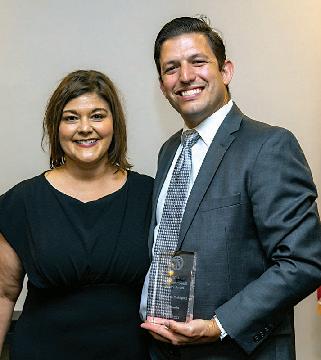
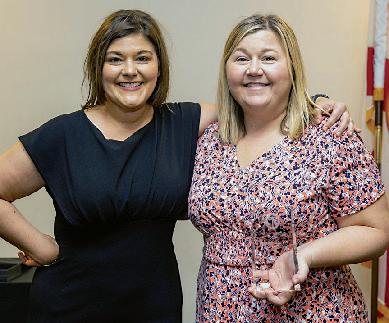



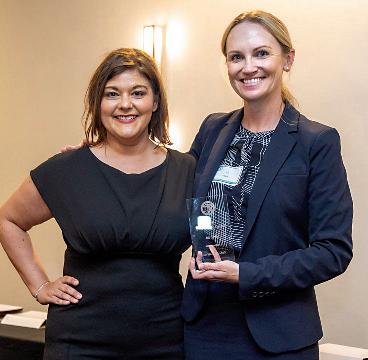

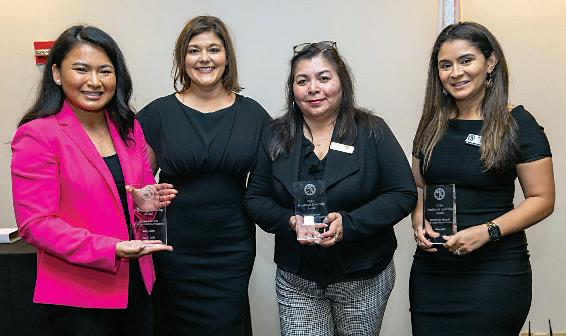
May 18, 2023
Embassy Suites Downtown Orlando
Title Sponsor:
Burnt Out on Burnout: New Outlook on Stress for 2023

s we are in the three-year mark of the global pandemic with up and down waives of new variants that continue to sweep the country, many of us are experiencing more burnout than ever. Not to mention that many firms are still adjusting to staff working remotely and reinstating back to working in-office polices which inevitably brings about new issues.
We’re burnt out on being burnt out. From the essential workers who had to continue to show up for our community to those still working from home, where the lines between professional and personal life have blurred, the burnout has, quite literally, reached epidemic proportions. According to a American Psychological Association report, burnout is at an all-time high across professions. 79% of employees had experienced work-related stress in the last year prior to their survey, and nearly 3 in 5 employees reported negative impacts of work-related stress, including lack of interest, motivation, or energy at work. 36% reported cognitive weariness, 32% reported emotional exhaustion, and 44% reported physical fatigue, which is a 38% increase since 2019.
The inconvenient reality is there’s no quick fix for burnout, especially the extreme kind so many are experiencing now. But with summer approaching and children out of school, it’s a fruitful time to reconsider our personal outlooks and strategies. Here, experts break down what burnout is, the optimal strategies for treating it, and how to ultimately change your outlook.
What is burnout?
The “occupational phenomenon” of burnout, as the World Health Organization refers to it, is commonly understood as a condition that is the result of chronic stress in the workplace that hasn’t been successfully managed. It was originally thought to be specific to the human-services sector, but nowadays it is recognized as a serious occupational health condition in most sectors. It’s very insidious and can sneak up on us when we burn the candle at both ends for an extended amount of time. While burnout is a form of stress, it’s important to know the distinction between the two. You can recover from stress with certain management techniques, but burnout is a totally different animal resulting from cumulative stress that hasn’t been managed. Once burnout gets its hooks into you, you can’t cure it by taking a long vacation, slowing down, or working fewer hours.
What are the symptoms of burnout?
The key symptoms of burnout boil down to exhaustion in the form of a deep kind of fatigue that isn’t curable by resting. This permanent state of exhaustion can have ripple effects, too. It also tends to be accompanied by a very negative assessment of our accomplishments, skills, efficacy and the value of our work, and feelings of resentment about the people with whom we work – be that colleagues, clients, or the organizations in which we are embedded. When we are in a state of burnout, we may also experience brain fog and an inability to concentrate. We may be prone to procrastinate and engage in endless displacement activities. We may even have a proper nervous breakdown and become completely unable to function at work.
How did the global pandemic impact burnout?
The isolation spurred by the pandemic had a dramatic impact on the work lives of many. If we are working from home, that blurs the boundaries between our private and our work lives, between leisure and work time,” explains Anna Katharina Schaffner, a cultural historian. “The work/non-work boundary is no longer marked by walks or commutes to work and changes of location. It is much easier for work to bleed into our lives in a boundaryless kind of way.” continued page 20
The isolation of the pandemic also cut people off from friends and support systems. We all experienced, and quite frankly, got used to Zooming with them, but after being on screen all day, more screen time certainly was not appealing, and we know that people suffer from Zoom burnout. Along with fear of getting sick, concerns about children falling behind in school, it is no surprise burnout has become dramatically worse.
It can be said that there was disproportionate impact the pandemic had on women, with many experience the stress of working, with childcare and home-schooling. With the same number of hours available in a day, people had to do the same amount of work plus care for our children 24/7. With that environment and lifestyle, getting some sleep and practicing basic self-care, is almost mathematically and practically impossible. What’s more: These compromises come at a psychological cost. The idea of failing at work and at the education/parenting front resulted in constant feelings of guilt and failure. It is totally unsurprising that many women suffered from severe burnout during the pandemic.
How to Find Relief From Burnout – here is what my research found: Set Firm Boundaries In today’s world, setting boundaries is becoming increasingly harder and harder by the day – but that doesn’t mean you shouldn’t try. To start, saying no to things more often and creating structure, such as not checking work email or taking work phone calls after certain hours and, on your days off.
Change a Life in Sixteen Weeks
What if I told you that you could change the world in just 16 weeks? Well, that’s not what this article is about. But you can change the life of a fellow lawyer in just 16 weeks. Not only that, but in those 16 weeks you could garner more business, gain new perspectives, and boost your self-confidence. What is this amazing activity? Mentoring, of course!
If you have been a mentor to a young lawyer, then you already appreciate much of this. But if not, let me explain. Brand new lawyers have lots of questions. Questions about handling cases. Questions about running a law practice. Questions about dealing with opposing counsel. Most of the questions are fairly simple and straightforward for a lawyer that’s been practicing ten years or more, but they can be daunting issues to the new lawyer.
One of the things that mentoring teaches you pretty quickly is how much you’ve learned since you started practicing. While most lawyers are not lacking in confidence (at least not outwardly), everyone can use a little pick-me-up. After meeting a mentee for lunch, you might walk away feeling pretty good about yourself because you will likely have known the answers to the myriad questions that this new lawyer was throwing at you.
When your mentee calls you in the middle of the afternoon in a panic because of something that happened in a case, you might surprise yourself at how well you are able to guide them toward a resolution. If you’ve been practicing for a while, you have certainly had moments in a case where everything was going wrong, and you weren’t quite sure how to proceed. Your experience has given you the perspective and resources to navigate the situation. But as a newly-minted lawyer, your mentee likely doesn’t know where to turn – unless they can turn to you, their mentor, for some advice. Often the mentee is not looking for “the answer” but, instead, just needs someone to talk them through the issues.
Mentors often report gaining valuable perspective from their mentee. Mentees tend to be younger than their mentors (although there are exceptions) which gives mentors the opportunity to gain insight into the younger generation. Since some members of that younger generation will likely be the mentor’s clients and colleagues, this can lead to better and more successful partnerships. Finally, an often-overlooked but very real side-benefit to mentoring is that it can be a great source of referrals. Your mentee probably doesn’t know too many experienced attorneys. So, when your mentee has an issue come across his or her desk that they can’t or don’t handle, you are likely to be their first phone call. I have received quite a few referrals over the years from lawyers that I first met while mentoring them.
The OCBA Mentoring Program is, of course, 16 weeks long. It pairs lawyers that have ten years or more of experience (or are board certified) with young lawyers looking for a mentor. Over those 16 weeks, a mentor is expected to connect with their mentee at least four times. Those can be in-person or virtual, but in-person is generally more effective at building a relationship and facilitating discussion. And it does not have to add much to your schedule. You can simply bring your mentee along to whatever you’re already doing (OCBA monthly luncheon, happy hours, hearings, etc.). Indeed, the Mentoring Program kick-off luncheon that happens at the OCBA offices can count as one of your four meetings.
The program begins in the fall and runs through the first of the year. Applications are online and can be accessed from the OCBA’s website at the Programs tab. The entire application process takes only a couple of minutes. Please consider completing an application and encouraging your colleagues to do so. The more mentors that sign up, the better job the program can do of matching mentors with mentees. Better matches, in turn, create better relationships and facilitate all of the benefits of mentoring.

Prioritize Self-Care Making time for self-care, whatever that looks like to you, is an essential part of preventing and treating burning out. Some people gain energy via socializing and connecting with others, while others will refuel by walking in nature, reading, painting, baking, cooking, and doing sports. Find out what re-energizes you.
Find Balance If you spend a lot of time sitting and staring at a screen at work, you should do something else to recharge in the evening and at weekends. If you are out all day moving and talking to people, you might need quiet and stillness. Your resting behaviors should be different from what we do at work. Trying and experiencing new things, learning about new topics and seeing new places and people.

Take Microbreaks and Implement Microchillers
Microbreaks are tiny, impromptu respites during the workday. Five or 10 minutes is the ticket throughout the day: get up, look out a window, get a snack, step outside, and feel the breeze on your face, walk around the block. Microchillers, which are small doses of selfcare of five minutes or less throughout the day. Think: mindful observation and/or meditation. Practice being in the present moment—listing as many sounds and sights as you can: the birds, traffic, just notice all the sounds you are aware of, things you see around you, smells in the air, breeze through your hair for three to five minutes. Take a deep breath. This activates your rest and digest response of your parasympathetic system or the brakes.”
Seek Support If Needed If all else fails, seek out a professional who can help you see the water you’re swimming in and guide you to develop a self-care plan to prevent burnout.
Change your outlook Break down what is or isn’t in your control. Your outlook is one thing you can adjust, and that can be a good place to start when looking to break out of burnout. Turn the stressor around and ask, ‘How can I make this work to my advantage?’; ‘Can I find something positive in the negativity?’; or ‘What can I overcome or manage in this situation?’”










